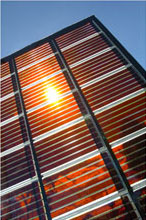Scientists have achieved a record light conversion efficiency of 8.2% in solvent-free dye-sensitized solar cells. This breakthrough in efficiency without the use of volatile organic solvents will make it possible to pursue large scale, outdoor practical application of lightweight, inexpensive, flexible dye-sensitized solar films that are stable over long periods of light and heat exposure.
The new paper published online June 29 in the journal Nature Materials by EPFL professor Michael Graetzel, Shaik Zakeeruddin and colleagues from the Changchun Institute of Applied Chemistry at the Chinese Academy of Sciences.
Dye-sensitized solar cell technology, invented by Michael Grätzel at EPFL in the 1990s, shows great promise as a cheap alternative to expensive silicon solar cells. Dye-sensitized cells imitate the way that plants and certain algae convert sunlight into energy. The cells are made up of a porous film of tiny (nanometer sized) white pigment particles made out of titanium dioxide.
The latter are covered with a layer of dye which is in contact with an electrolyte solution. When solar radiation hits the dye it injects a negative charge in the pigment nanoparticle and a positive charge into the electrolyte resulting in the conversion of sunlight into electrical energy. The cells are inexpensive, easy to produce and can withstand long exposure to light and heat compared with traditional silicon-based solar cells.
Currently, state-of-the-art dye-sensitized cells have an overall light conversion efficiency greater than 11%, still about two times lower than silicon cell technology.
A major drawback to the dye-sensitized cell technology is the electrolyte solution, which is made up of volatile organic solvents and must be carefully sealed. This, along with the fact that the solvents permeate plastics, has precluded large-scale outdoor application and integration into flexible structures.
To overcome these limitations, Grätzel and his colleagues developed a new concept -- a mixture of three solid salts as an alternative to using organic solvents as an electrolyte solution. When the three solid components are mixed together in the right proportion they turn into a melt showing excellent stability and efficiency.
Grätzel is confident that further development of these types of electrolyte mixtures will lead to large-scale practical application of dye-sensitized solar cell technology, reinforcing solar energy's role as a cornerstone of alternative energy production.

